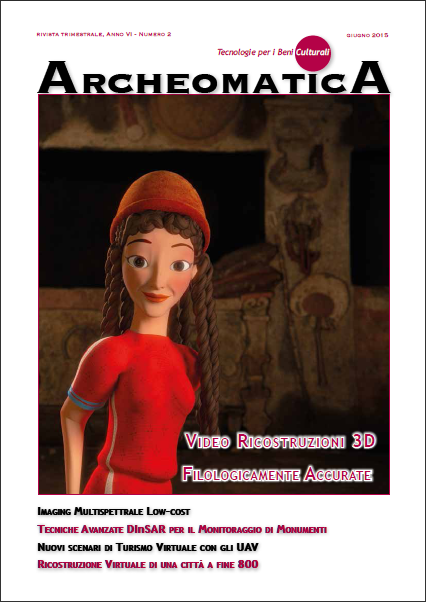La Sora scomparsa di fine '800
DOI:
https://doi.org/10.48258/arc.v6i2.1039Parole chiave:
GIS, DTM, Georeferenziazione, Modellazione 3D, Beni Culturali, Tecnologie, Sora, Terremoto 1915Abstract
The Earthquake of Marsica in 1915, whose centenary was remembered on 13th January 2015, destroyed almost completely the town of Sora (FR). The earthquake caused many victims and important damages to the artistic heritage: Lots of ancient buildings and churches were completely lost. The following reconstruction deeply modified the urban settlement of the town, which dated back to the 17th century. This study presents a virtual reconstruction of the town by means of information technologies and in particular of Geographic Information Systems (GIS). For this purpose, the cadastral map of 1876 has been digitalised in order to get the layers of data regarding buildings and walls; data which were incorporated in an ArcGis (ESRI) geodatabase. Each information has been georeferenzed considering all the points of the 1876 map which had not changed in comparison to the current layout. This information has been projected on orthophotos and on a Digital Terrain Model (DTM) and subsequently extruded according to heights which have been estimated from the photographic documentation of the time. Some of the most important buildings have been reconstructed with more accuracy than what was obtained by the only map extrusion, by adding details available from historical pictures. The final result might be further developed for a more detailed reconstruction extended to the whole town, by using for exemple CityEngine (ESRI), modeling softwares and a procedural modeling approach.Riferimenti bibliografici
⦠Panzeri M. & Cataldo G. (2000) Sistemi Informativi Geografici e Beni culturali, Torino: Celid.
⦠Forte M. (2002) I Sistemi Informativi Geografici in archeologia, Roma: MondogGIS Srl.
⦠Rossi M. & Salonia P. (a cura di) (2003) Comunicazione multimediale per i Beni Culturali, Milano: Pearson Addison – Wesley.
⦠Favretto A. (2006) Strumenti per l'analisi geografica GIS e telerilevamento, Bologna: Pà tron Editore.
⦠Migliaccio F. (2007) Sistemi Informativi Territoriali e Cartografia, Milano: Maggioli Editore.
⦠Bianchini M. (2008) Manuale di rilievo e di documentazione digitale in archeologia, Roma: Aracne Editrice Srl.
⦠Masetti C. (a cura di) (2008) Dalla Mappa al GIS, Atti del Primo Seminario di Studi, Genova: Brigati.
⦠Panzeri M. & Farruggia A. (a cura di) (2009) Fonti, metafonti e GIS per l'indagine della struttura storica del territorio, Torino: Celid.
⦠Carbone A. (1970) La Città di Sora, Casamari (FR): Tipografia dell'Abbazia di Casamari.
⦠Beranger E.M. (1981) La cinta muraria di Sora nel quadro delle fortificazioni in opera poligonale della Media Valle del Liri, Sora (FR): Centro di Studi Sorani V. Patriarca.
⦠Tanzilli A. (1982) Antica topografia di Sora e del suo territorio, Isola del Liri (FR): Tipografia Editrice M. Pisani.
⦠Loffredo L. (1985) Sora - storia, archeologia, folklore, tradizioni; itinerari turistici, Roma: Edizioni Terra Nostra.
⦠Beranger E.M., Ferracuti M. & Gulia L. (2001) Itinerari d'arte e luoghi di cultura, Sora (FR): Centro di Studi Sorani V. Patriarca, F.lli Palombi Editori.
⦠Conte A. (2007) Il fiume e le pietre (1° edizione), Isola del Liri (FR): Arti Grafiche Pasquarelli.
⦠Conte A. (2012) Il fiume e le pietre (2° edizione), Isola del Liri (FR): Arti Grafiche Pasquarelli.
##submission.downloads##
Pubblicato
Come citare
Fascicolo
Sezione
Licenza
Gli autori che pubblicano su questa rivista accettano le seguenti condizioni:- Gli autori mantengono i diritti sulla loro opera e cedono alla rivista il diritto di prima pubblicazione dell'opera, contemporaneamente licenziata sotto una Licenza Creative Commons - Attribuzione che permette ad altri di condividere l'opera indicando la paternità intellettuale e la prima pubblicazione su questa rivista.
- Gli autori possono aderire ad altri accordi di licenza non esclusiva per la distribuzione della versione dell'opera pubblicata (es. depositarla in un archivio istituzionale o pubblicarla in una monografia), a patto di indicare che la prima pubblicazione è avvenuta su questa rivista.
- Gli autori possono diffondere la loro opera online (es. in repository istituzionali o nel loro sito web) prima e durante il processo di submission, poiché può portare a scambi produttivi e aumentare le citazioni dell'opera pubblicata (Vedi The Effect of Open Access).





